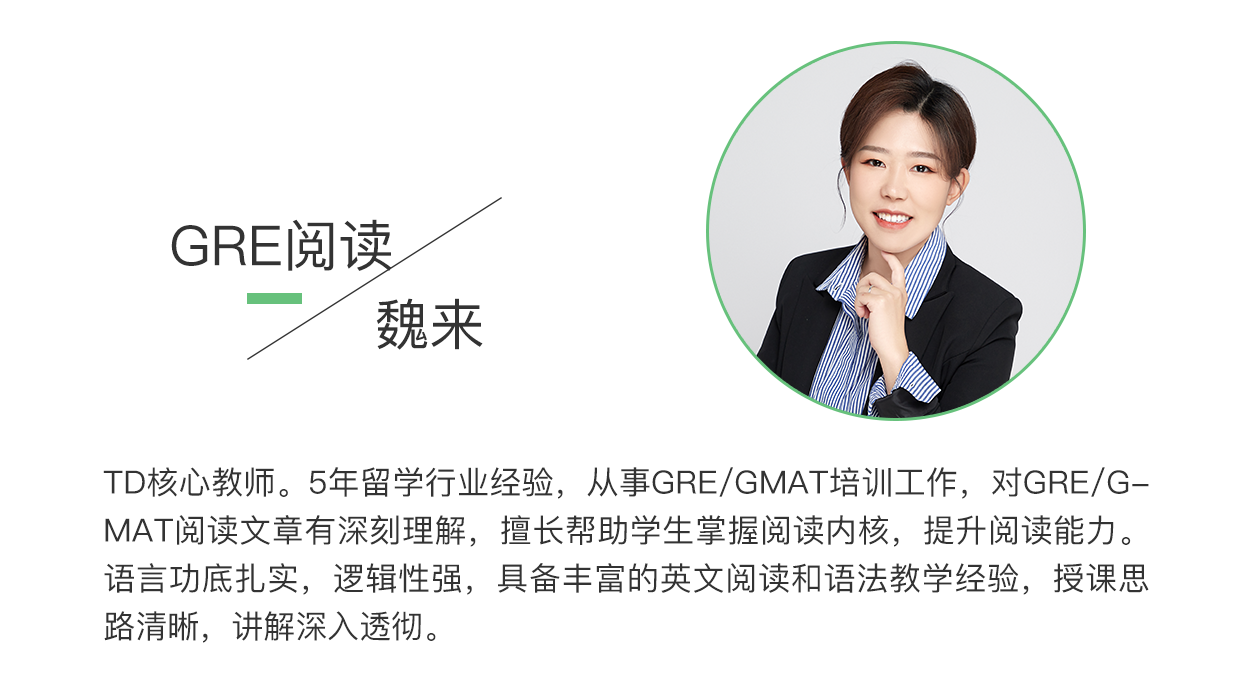 市面上流传的GRE阅读机经真题有三百多篇,同时又存在多种版本的答案和解析,有些疑难题目让考生不知道听谁的,还有些版本的解析像是用谷歌翻译把同题目和选项翻译了一下。厚朴GRE认为,GRE阅读的解析,可以讲得再清楚一点。
GRE不光有技巧,不光有快速解题法,GRE更加考察大家的逻辑硬实力,文字理解实打实的深度。良好的GRE备考应当在课堂上向老师学习快速解题法,取同取反逻辑的同时,课下扎扎实实的读懂每一句话。读懂,是一切技巧使用的前提。皮之不存,毛将焉附?
有感于此,我们尝试用比较长的时间,原创一个解析,力求做到超详细,大白话,包你懂。之前为大家推送了Passage1-97的解析,今天继续为大家推出Passage 98(逻辑单题)解析,这篇阅读一共有1段,共1道题,厚朴GRE版超详细「包你懂」系列对此篇文章进行了清楚地解析。
Passage 98
The crustaceans known as harpacticoids are very widespread in marine sediments, where they feed on microorganisms by ingesting the sediment particles to which the microorganisms adhere. Heavy metals, such as those found in industrial pollution, readily adhere to sediment particles. Harpacticoids are poisoned by heavy metals but are unaffected by most other pollutants. Therefore the concentration of harpacticoids in an area is a good indication of whether that marine environment contains heavy metals.
市面上流传的GRE阅读机经真题有三百多篇,同时又存在多种版本的答案和解析,有些疑难题目让考生不知道听谁的,还有些版本的解析像是用谷歌翻译把同题目和选项翻译了一下。厚朴GRE认为,GRE阅读的解析,可以讲得再清楚一点。
GRE不光有技巧,不光有快速解题法,GRE更加考察大家的逻辑硬实力,文字理解实打实的深度。良好的GRE备考应当在课堂上向老师学习快速解题法,取同取反逻辑的同时,课下扎扎实实的读懂每一句话。读懂,是一切技巧使用的前提。皮之不存,毛将焉附?
有感于此,我们尝试用比较长的时间,原创一个解析,力求做到超详细,大白话,包你懂。之前为大家推送了Passage1-97的解析,今天继续为大家推出Passage 98(逻辑单题)解析,这篇阅读一共有1段,共1道题,厚朴GRE版超详细「包你懂」系列对此篇文章进行了清楚地解析。
Passage 98
The crustaceans known as harpacticoids are very widespread in marine sediments, where they feed on microorganisms by ingesting the sediment particles to which the microorganisms adhere. Heavy metals, such as those found in industrial pollution, readily adhere to sediment particles. Harpacticoids are poisoned by heavy metals but are unaffected by most other pollutants. Therefore the concentration of harpacticoids in an area is a good indication of whether that marine environment contains heavy metals.
文章解析
第一句: The crustaceans known as harpacticoids are very widespread in marine sediments, where they feed on microorganisms by ingesting the sediment particles to which the microorganisms adhere. 白话版讲解: 有种甲壳纲动物叫猛水蚤目,这种动物在海洋沉积物中非常常见,它们以吸附在泥沙中的微生物为食。 第二句: Heavy metals, such as those found in industrial pollution, readily adhere to sediment particles. 白话版讲解: 另外,一些诸如在工业污染物中存在的重金属也会吸附在沉积的泥沙中。 第三句: Harpacticoids are poisoned by heavy metals but are unaffected by most other pollutants. 白话版讲解: 猛水蚤目会受到这些重金属的毒害,但是不受其它大部分污染物的影响。 第四句: Therefore the concentration of harpacticoids in an area is a good indication of whether that marine environment contains heavy metals. 白话版讲解: 因此,一块水域里面猛水蚤目数量的多少就能够反应出这块水域的重金属含量多不多。题目解析
1.Which of the following is an assumption on which the argument relies? A. Industrial pollution is the principal source of heavy metals in marine sediments. B. Harpacticoids are the only crustaceans that feed on microorganisms by ingesting sediment particles. C. Harpacticoids are more susceptible to poisoning by heavy metals than are other marine organisms. D. The microorganisms that harpacticoids feed on are not killed by pollutants that are harmless to harpacticoids. E. The microorganisms that harpacticoids feed on absorb heavy metals.(下方查看答案)
▼
 这道题问的是,原文的论证过程是建立在以下哪个假设的基础之上的?假设题我们可以用“选项取反,则结论不成立”的方法来解题。原文的结论是一块水域里面猛水目数量的多少就能够反应出这块水域的重金属含量多不多。我们依次对每个选项进行取反,看看哪个可以推翻这个结论。
A. 海洋沉积物中的重金属,其主要来源是工业污染。(不管重金属的主要来源是不是工业污染,对结论中猛水蚤目的数量和重金属之间的关系都不会产生影响。)
B. 猛水蚤目是甲壳纲动物中,唯一一个以吸附在泥沙中的微生物为食的。(同上)
C. 猛水蚤目比其它海洋生物更容易受到重金属的毒害。(同上)
D. 猛水蚤目的食物,也就是吸附在泥沙中的微生物,它们不会受到那些对猛水蚤目无害的污染物的毒害。(如果把这个选项取反, 猛水蚤目的食物会受到污染物的毒害,那么猛水蚤目的食物来源就会减少,从而导致猛水蚤目的数量减少。这样一来,猛水蚤目的数量减少就并不能说明重金属的含量也在减少。)
E. 猛水蚤目的食物,也就是吸附在泥沙中的微生物,它们也会吸入重金属。(文章没有提到重金属对微生物的影响,所以不能判断这个选项取反之后对原文结论的影响。)
这道题问的是,原文的论证过程是建立在以下哪个假设的基础之上的?假设题我们可以用“选项取反,则结论不成立”的方法来解题。原文的结论是一块水域里面猛水目数量的多少就能够反应出这块水域的重金属含量多不多。我们依次对每个选项进行取反,看看哪个可以推翻这个结论。
A. 海洋沉积物中的重金属,其主要来源是工业污染。(不管重金属的主要来源是不是工业污染,对结论中猛水蚤目的数量和重金属之间的关系都不会产生影响。)
B. 猛水蚤目是甲壳纲动物中,唯一一个以吸附在泥沙中的微生物为食的。(同上)
C. 猛水蚤目比其它海洋生物更容易受到重金属的毒害。(同上)
D. 猛水蚤目的食物,也就是吸附在泥沙中的微生物,它们不会受到那些对猛水蚤目无害的污染物的毒害。(如果把这个选项取反, 猛水蚤目的食物会受到污染物的毒害,那么猛水蚤目的食物来源就会减少,从而导致猛水蚤目的数量减少。这样一来,猛水蚤目的数量减少就并不能说明重金属的含量也在减少。)
E. 猛水蚤目的食物,也就是吸附在泥沙中的微生物,它们也会吸入重金属。(文章没有提到重金属对微生物的影响,所以不能判断这个选项取反之后对原文结论的影响。)
本文作者

TD福利 & 领取方式
厚朴GRE还特别为大家准备了「GRE阅读真题」无条件分享给大家~赶紧私戳小马甲并发送暗号「GRE阅读」即可领取资料啦~











